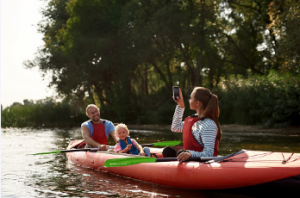There are many different kinds of kayak gear you can purchase. These can include a wetsuit, paddle floats, dry bags, paddles, and floats. In addition, some people have physical disabilities or shoulder problems and require special equipment to paddle safely. This article will cover top gear options to help you prepare for kayaking adventures. Once you know what you’ll need, it’s time to shop for your gear.
 Wetsuits
Wetsuits
Wetsuits for kayak gear should be durable, comfortable, and designed for varying water temperatures. Wetsuits are typically made of neoprene, a synthetic material with many tiny air pockets. Thickness is proportional to insulation and is measured in millimetres. The thicker the wetsuit, the warmer it will keep you. Wetsuits have different thicknesses in different body parts, and the thickness of different components will affect the amount of insulation provided.
Wetsuits for kayaking can come in a variety of materials. A standard farmer john wetsuit is a sleeveless, three to five mm thick piece of clothing. It is usually paired with a rash guard or synthetic shirt. Paddle jackets with hoods are also an excellent choice for cold weather paddling. If you are unsure what kind of wetsuit is right for you, check out Patagonia’s wetsuit.
Dry bags
If you plan on carrying a lot of kayak gear while paddling, dry bags can come in handy. They protect your equipment from water damage, while bright colours are easier to spot if you go overboard. Bright colours also make you more visible in the forest. However, you should choose a dry bag with a sealed air barrier if you plan on travelling to a rainy place. Here are a few tips to help you make the right decision:
First, know the size of the dry bag you need. A 10-litre dry bag will keep essential items dry for a few hours. It has room for a cell phone, wallet, and change of clothes. Larger dry bags, such as 30 or 40 litres, are recommended for multi-day kayaking trips. These will have room for dry clothes and camping gear. If you plan to use dry bags for kayaking regularly, you should consider buying more than one.
Float bags
Float bags for kayak gear are essential accessories for any boater. If you capsize your kayak, they will keep you afloat by replacing water in the vessel. These bags come in many sizes and are easy to install. Before you purchase one, make sure you measure the space in your kayak’s compartment. A giant float bag will fit better. Float bags are simple to install and will ensure you always have the gear you need.
Float bags come in various styles and sizes, and there is a bag to suit any kayak. The NRS float bag is an excellent choice for those who have kayaks without a central pillar. It is available in three different sizes and fills up the entire compartment. Its durable urethane material is incredibly strong and will not delaminate or leak. In addition, the bag comes with an extra-long inflation and deflation tube.
Paddle floats
Paddle floats for kayak gear are designed to keep your paddle in place while kayaking. In addition, it serves as a lever and stability for re-entering the kayak if you are in trouble. These floats can be inflated with one hand and deflated with a similar procedure. Generally, paddle floats can be inflated in less than a minute so that you can use them immediately.
Paddle floats for kayak gear are essential kayaking safety gear. They can help you avoid getting into trouble by enabling you to re-enter the kayak after a capsize quickly. Some floats can be inflatable, while others are made of foam. Make sure to check for thorns before purchasing inflatable kayak floats. Regardless of their size, paddle floats help kayakers remain comfortable while paddling.
Polarized sunglasses
If you plan on going on a kayaking trip, investing in some polarised sunglasses is a good idea. While not required, these glasses can reduce the strain on your eyes while floating. Non-polarized lenses do not stop horizontal light, and they will allow light to come in from all directions. In addition to preventing eye strain, polarized lenses should also provide truer colour reproduction, which is essential for boating and other activities.